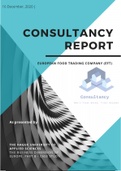Case
The Fish Case Report: Business Dimension of Europe (8.7)
- Course
- Institution
The Fish Case is the 1st year assignment for the class of The Business Dimension. EFT is a company in the that want to expand their trade by selling frozen fish product outside The Netherlands. The main research question is: What are the most attractive export markets for frozen fish products in th...
[Show more]



